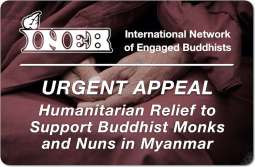tantric Buddhism
A special path which arose within Mahāyāna Buddhism based on treatises known as tantras and, while generally embracing the same aims, claimed to provide a rapid means to accomplish the goal of enlightenment (bodhi) by means of its distinctive techniques. Certain key features can be identified which serve to distinguish it from other forms of Indian Buddhism. It offers an alternative path to enlightenment; its teachings are aimed at lay practitioners in particular, rather than monks and nuns; it recognizes mundane (laukika) aims and attainments, and often deals with practices which are more magical in character than spiritual; it teaches special types of meditation (sādhana) as the path to realization, aimed at transforming the individual into an embodiment of the divine in this lifetime or after a short span of time; such kinds of meditation make extensive use of various kinds of maṇḍalas, mudrās, mantras, and dhāraṇīs as concrete expressions of the nature of reality; the formation of images of the various deities during meditation by means of creative imagination plays a key role in the process of realization; there is a proliferation in the number and types of Buddhas and other deities; great stress is laid upon the importance of the guru and the necessity of receiving the instructions and appropriate initiations for the sādhanas from him; a spiritual physiology is taught as part of the process of transformation; it stresses the importance of the feminine and utilizes various forms of sexual yoga.
The origins of this movement within Buddhism is shrouded in mystery but a consensus of modern scholars place the emergence of tantric Buddhism as a distinct path around the 7th century ce among circles of adepts based in the regions corresponding to present-day Orissa, Bengal, Gujarat, and Kashmir. Many elements that make up its doctrines, meditational practices, and rituals can be found considerably earlier both within Buddhism and without—meditative visualization was known from texts such as the Pratyutpanna Sūtra and the Sukhāvatī-vyūha Sūtra; maṇḍalas can be seen as idealized stūpas, dhāraṇī texts were in use before the 1st century ce, the ritual of fire-offerings (homa) derives from vedic practice. These various elements were gradually combined over the centuries until the emergence of recognizable tantric texts such as the Mahā-vairocana-abhisaṃbodhi in the mid-7th century, which included all the hallmarks of tantric Buddhism listed above with the exception of sexual yoga. By the end of the 7th century, the Sarva-tathāgata-tattva-saṃgraha and other texts had been composed, now utilizing the Five Buddha Family system in contrast to the earlier three Buddha family system. Within a few decades, the Guhyasamāja Tantra was next composed, the first tantra known to contain explicit sexual imagery. This was followed by an explosion in the number of tantric texts appearing in India, both along the lines of the Guhyasamāja and texts like the Hevajra Tantra which make greater use of sexual yoga, an internal spiritual physiology, and emphasize the role of the feminine to a greater extent. This period also saw the rise of the mahā-siddhas and the antinomian practices associated with Sahajayāna. With the emerging diversity of tantric texts, various schemes were used to classify them. Initially, tantric Buddhism was seen as an alternative path within Mahāyāna and was termed the mantra method (mantra-naya) in contrast to the Perfection method (pāramitā-naya). This mantra method was subdivided into two groups— kriyā-tantra, emphasizing rituals, and yoga-tantra emphasizing meditative practices—the former group including texts such as the Subāhu-paripṛcchā and the Susiddhikara, while the latter included the Sarva-tathāgata-tattva-saṃgraha and the Guhyasamāja. The Mahā-vairocana-abhisaṃbodhi was deemed to share features of both groups and thus was placed in a special dual (ubhaya) category. At a later date, this system was revised into the now standard fourfold division of kriyā-tantra, caryā-tantra, yoga-tantra and anuttara-yoga-tantra. Anuttara-yoga itself was further subdivided into three categories: Father Tantra, Mother Tantra, and Non-dual Tantra, although it seems that other naming systems were used such as mahāyoga, anuyoga, and atiyoga still utilized by Tibetans in Nyingma circles.
Although tantric Buddhism seems likely to have originated outside monastic circles among unorthdox yogins, it was soon introduced into the various great centres of Buddhist such as Nālandā, Vikramaśīla, and Ratnagiri. Many of the greatest scholar-monks in India from the 8th century onwards were also renowned as adepts who produced a considerable volume of commentarial literature and independent treatises. Through their influence, tantric Buddhism became widespread throughout India and neighbouring countries. However, although it is known to have been transmitted to Sri Lanka, Burma, Thailand, and Indonesia, outside of India tantric Buddhism achieved its greatest success in Tibet and China, with Shingon as a secondary offshoot in Japan.













